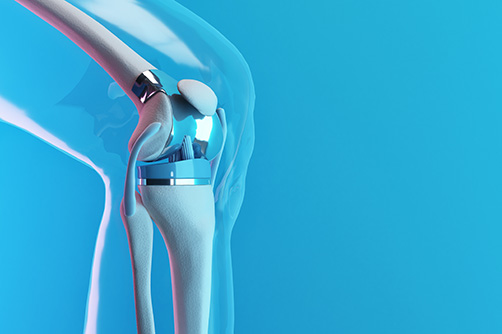Knee Replacement Prosthetic Surgery Prices, Details and Aftercare in Turkey
The Knee Joint
When we walk, straighten or bend our leg, our largest joint is active - the knee joint.It is the flexible connection between the femur and tibia and allows extension and flexion of the lower leg.
The knee joint consists of the connection of three bones: the femur (thigh bone), the tibia (lower leg bone) and the patella (kneecap). These bones are held together by strong ligaments, muscles, and tendons. In between there is a joint space, in which the menisci (intermediate joint discs) are located. They absorb pressure and stress. A healthy knee is pain free and fully mobile.
The painful loss of normal joint function has various causes. The most common are joint wear (arthrosis), chronic inflammation (rheumatism) and accidental or congenital deformities. With the implantation of an artificial joint replacement (endoprosthesis), a team of experienced surgeons enables you to restore joint function, freedom from pain and mobility.
At Innovacare partner clinics hundreds of patients are treated with endoprostheses in knee and hip joints every year. Depending on the personal situation and findings, various implants, anchoring options and surgical techniques can be considered. Your surgeon takes the time to discuss all the details with you. Excellent long-term results of over 15 years and longer can be expected thanks to our surgical experience, care in checking the indication and consistent follow-up treatment.
Knee Replacement Surgery in Turkey
From a mechanical point of view, the knee joint is the human joint with the most complicated structure. Due to its high demands, it therefore often develops wear and tear (arthrosis) with increasing age.In the course of our lives we bend and straighten our knees more than 10 million times. 10 muscles and 15 tendons are involved in the function of the knee joint. If there is a high degree of wear and tear of the cartilage in the knee joint, after all conservative treatment options have been exhausted, the implantation of an artificial joint is recommended in the case of corresponding complaints.
After an appointment for the operation has been agreed with you, the implant is individually planned with the help of a special prosthesis planning program on the basis of x-rays specially made in our practice.
Various materials are available for this purpose, which are used in the event of an allergy or also serve to improve durability.
What Type of Artificial Knee Joint is Used?

This depends on the extent of knee joint wear and the condition of the stabilizing ligaments. If only part of the knee joint is affected by wear and tear, it may be possible to replace just this part with an artificial joint. Often the inner part of the joint is affected, which can be replaced by a so-called sled prosthesis. This procedure is somewhat less complex than installing a knee endoprosthesis, in which all parts of the joint have to be replaced. However, in the case of advanced changes in the knee joint involving several joint sections, this is necessary in order to enable the best possible improvement in symptoms.
Internal partial joint replacement (“sled prosthesis”)
If only the inner part of the knee joint is affected by wear and tear (arthrosis), this can very well be replaced by a so-called sled prosthesis. This can be implanted via a smaller incision, sometimes minimally invasive, without damaging the muscles. All ligaments of the knee joint and the outer part of the joint surface remain intact.
Partial joint replacement of the patellar bearing ("femoropatellar replacement")
In many patients, only the part behind the kneecap is affected by advanced wear. Here there is the possibility of replacing these joint surfaces behind the kneecap and correspondingly replacing the slide bearing for the kneecap on the thigh. All ligaments, menisci and the inner and outer parts of the joint remain intact.
Surface replacement ("knee TEP")
If the entire cartilage surface is worn down and the collateral ligaments are still intact, we recommend a surface replacement. In order to ensure even greater precision and the best possible individual adaptation of the implant, we offer the option of planning an individual cutting block before the operation. If the knee joint is badly deformed and the side ligaments are severely loosened, an implant with a shaft anchorage must be used to provide stability. Only a few millimeters are removed from the cartilage in order to apply the implant with a precise fit.
Reoperation with existing knee implant
In rare cases, despite the presence of a knee implant, there are still some complaints, which can have various causes:
- scarring and adhesions
- Pain syndrome behind the kneecap
- instability problem
- Loosening or wear of the implant
- inflammation
Before another operation takes place, some examinations, such as functional examination, puncture, X-ray, if necessary computer tomography, if necessary skeletal scintigraphy must be carried out in advance.

Arthroscopy with existing knee implant
Adhesion and scarring as well as trapped soft tissue can be repaired very well with a minimally invasive surgical procedure. However, a strict follow-up treatment plan is also very important for the success of the treatment, which is determined individually for you by the surgeon.
Replacement of the back surface of the kneecap
In some cases, after the knee joint has been replaced, a pain syndrome develops behind the kneecap, for example due to progressive wear and tear in this area. Here, the isolated replacement of the back surface of the kneecap is recommended.
Changing the inlay (plastic insert)
If the inlay wears out over time and a certain instability develops, changing the inlay is recommended. The prerequisite for this is that the remaining parts of the implant are intact and not loosened.
Replacement or partial replacement of a knee TEP
A knee implant can loosen after many years, the average durability of a knee implant is about 15 years. But an implant can also come loose as a result of accidents or falls. Once the diagnosis has been confirmed, a replacement operation is always recommended.
Since these operations can also lead to partial bone loss and the resulting instability, revision implants are required with which the joint can be rebuilt.
Changing a revision implant
In the case of multiple previous operations with multiple replacement operations, the implantation of a special prosthesis (tumor prosthesis) may become necessary.
Examination of your knee before surgery
In the case of an operation, you will be informed of two dates, a preparation date and the operation date. During the preparation, the standard examinations that are necessary before an operation are carried out. This includes taking blood, providing information and preparing for anesthesia. The hospital stay is three to seven days, depending on the patient's general condition and mobilization.
Knee replacement surgery: How is it done?
Our surgeons use a muscle-sparing technique for all knee replacement surgeries. As a result, longer periods of partial load or relief of the leg are usually not necessary. The operation lasts about an hour and can be performed under general or partial anesthesia (spinal cord anaesthesia), depending on the agreement between the patient and the anesthesiologist. The knee joint is opened through a short skin incision across the inside of the joint. The worn joint surfaces are processed according to a special cutting plan, so that the artificial knee joint of the appropriate size can be well fitted to the bone. After the operation, the patients come to the recovery ward for one to two hours and are then taken back to the normal ward. For patients who require more intensive monitoring, we have an Intermediate Care Station and an Intensive Care Unit on-site.
Good systematic pain management ensures lasting pain relief or relief. Conventional painkillers are used for this. For the critical time (a few hours to days after the operation), so-called thin pain catheters can be placed in the groin as part of the preparation for the operation. These enable direct, local administration of painkillers.
Knee Replacement Surgery Hospital Stay and Aftercare
The inpatient treatment in our clinic takes about 6 to 10 days. During this time, our social services will work with you – if you wish – to choose a rehabilitation clinic for follow-up treatment. You can either be transferred directly to the rehabilitation clinic or travel from home after a short stopover. If you inform the rehabilitation clinic before the operation, the transition usually goes smoothly. You should use the time in the follow-up treatment to further improve your mobility and to specifically train the muscles that stabilize your knees.In the first days after the operation , the focus is on postoperative pain therapy and physiotherapy-guided movement therapy of the operated knee joint. A pain catheter enables effective pain relief in the first few days after the operation. You will get out of bed and take your first steps on the first day after the operation. Your mobility will increase every day until you are able to independently cover longer distances in our clinic. Our physiotherapists will support you. In the first few weeks you will be dependent on walking aids to improve your walking security and not to overload your operated knee.
Results to Expect After Knee Replacement Surgery
In the meantime, excellent long-term results of more than 15 years are available for the implants used in our clinic, which show a good functional result with largely freedom from pain in over 90% of cases. Only a few patients have to be operated on again on the affected knee within this period.Regular follow-up checks in our outpatient clinic with clinical and X-ray examinations enable us and you to monitor performance.
What to consider after knee replacement surgery?
Below are some important rules of conduct that will contribute to the success of the operation:
- continue the physiotherapeutic exercises learned after discharge from the clinic
- roll your foot properly
- Stick supports when walking
- upright walk with steps of equal length
- Wearing lace-up shoes with soft, elastic soles

In the first 12 weeks after the operation you should avoid any extreme loads on the knee. These include:
- shock loads
- Put the leg down in an O or X position
- squatting or kneeling
- Compressive loads
- lifting and carrying loads
- Overexertion and great exertion
- Weight gain (can lead to premature loosening of the prosthesis)
- Heavy physical work
Appropriate sports
The German Association of Sports Physicians has drawn up the following guidelines for sport for people wearing endoprostheses: Suitable types of sport are:
- general gymnastics
- cycling/exercise bike
- To swim
- Hike
Conditionally suitable sports (please consult your doctor!):
- playing golf
- Jogging
- Ski touring/cross country skiing
Sports not recommended:
- The sport of ball
- athletics
- Ride
- Tennis
- alpine skiing
Complications and Risks of Knee Replacement Surgery
Fortunately, complications from this surgery are very rare.The procedure can be carefully prepared and the risk of risk and complications can be reduced to a minimum. Despite all preventive measures, as with any other operation, there are also certain risks with knee prosthesis surgery.
These include: thrombosis, embolism, wound healing disorders, bruising, secondary bleeding, injuries to nerves, vessels and other anatomical structures, adhesions with poor mobility of the knee joint and residual pain.
However, all of these risks occur in less than 5% of cases and should in no way discourage knee replacement surgery. If the surgical technique is good and the patient handles the "new knee" correctly, the results after such operations are very good.
The success of the operation and the durability of the knee joint also depend to a large extent on the follow-up treatment and behavior afterwards. In the clinic, with the help of physiotherapists, you will learn how to use your joint again. You will learn how to stretch and bend your knees so that you can carry out daily chores (e.g. washing your body, getting dressed) independently after you have been released. With forearm supports you learn to walk on straight surfaces and stairs.
With a knee joint replacement, you can enjoy your life pain-free and with more movement again. But don't forget to visit your doctor regularly for follow-up examinations over the next few years!
Loose Knee Prosthesis
With the increasing number of endoprosthesis implantations, the problem of loosening of implants also increases. The replacement operation is complex and requires individual planning and implementation by an experienced surgeon. 
If you need to change an endoprosthesis, please bring the operation reports from the previous clinic and information about the implants used with you. This ensures that we can achieve the best possible result for you with the replacement surgery.